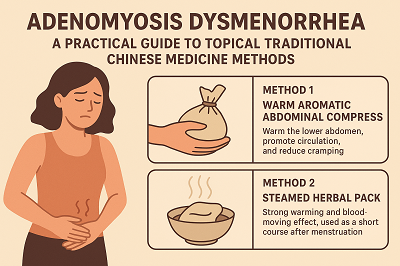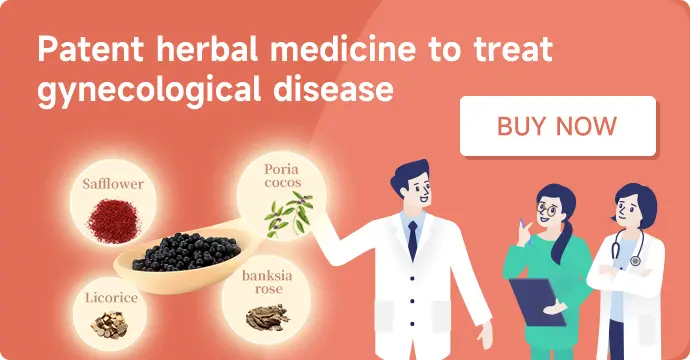Adenomyosis Dysmenorrhea: A Practical Guide to Topical Traditional Chinese Medicine Methods
Adenomyosis often brings deep, cramping pelvic pain that peaks around menstruation and can disrupt sleep, work, and daily life. Many women look for non-oral options that can be safely combined with standard care. In Traditional Chinese Medicine (TCM), adenomyosis-related menstrual pain is commonly associated with patterns like blood stasis, cold accumulation, qi stagnation, and dampness. Topical herbal therapies aim to warm the lower abdomen, promote circulation, and ease pain.
This guide summarizes practical external application methods used in TCM, how to prepare and apply them, and when they may be helpful. These approaches support symptom relief; they are not a cure and should be used alongside professional medical advice.

How TCM Understands Adenomyosis Pain
From a TCM perspective, dysmenorrhea in adenomyosis often reflects obstructed blood flow in the uterus. Cold congealing can tighten tissues, qi stagnation can reduce movement, and dampness can add heaviness and swelling. Treatment principles therefore focus on warming the lower abdomen, invigorating blood, dispersing stasis, and easing pain. Because individuals differ, herbs and methods are adjusted based on the predominant pattern and overall constitution. External methods are typically used as adjuncts to internal formulas, acupuncture, and lifestyle strategies.
Why Choose Topical Herbal Care
Topical TCM methods offer gentle, localized warmth and circulation support, which many patients patients find soothing during painful periods. They are helpful for those who prefer non-oral options or want to complement internal herbal therapy. Importantly, topical approaches generally relieve symptoms; they do not resolve the underlying adenomyosis. Consistency is key—regular application over several weeks is often needed to notice a meaningful change.
Method 1: Warm Aromatic Abdominal Compress
Core aim: Warm the lower abdomen, promote circulation, and reduce cramping.
Suggested herbal blend (proportions can be adjusted by a TCM practitioner):
Fennel seed and mugwort leaf as warming, aromatic bases
Angelica tail, white angelica (bai zhi), and red peony for moving blood and easing pain
Optional plant-based alternatives to strongly blood-moving animal products historically used in older formulas: consider sparganium or san leng instead of any endangered animal materials
Preparation and use:
Coarsely grind the herbs and place them in a clean cotton or linen sachet.
Warm the sachet by placing it over a hot water bottle or using a steamer until comfortably warm.
Apply over the lower abdomen for about 20–30 minutes in the evening.
Use several nights per week, and adjust frequency based on comfort.
Safety tips:
Do not use excessively hot packs; skin should feel warm, not burning.
Avoid use over broken skin, rashes, or if you are pregnant.
Stop if you experience irritation or worsening pain.
Method 2: Steamed Herbal Pack (Post-Menses Course)
Core aim: Strong warming and blood-moving effect, used as a short course after menstruation.
Suggested herbal blend (powdered):
Warming and pain-relieving herbs such as qiang huo, frankincense (ru xiang), myrrh (mo yao), and Sichuan pepper (hua jiao)
Circulation-supporting herbs like dipsacus (xu duan), acanthopanax (five-add skin), white angelica, red peony, and angelica tail
Penetrating and warming bases including “penetrating bone herb” (tou gu cao) and mugwort leaf
Preparation and use:
Grind the herbs into a uniform powder and place into a cotton pack.
Steam the pack with gentle heat (e.g., above simmering water) until warm.
Apply to the lower abdomen for 20–30 minutes once daily.
Begin about three days after your period has ended, and continue daily until the next cycle. Pause during menstruation, especially if bleeding is heavy, to avoid adding heat that may increase flow.
Safety tips:
Monitor for skin redness or sensitivity; reduce duration if needed.
This approach is not suitable during active pelvic infections or for those with pronounced heat signs (e.g., fever, burning pain).
Method 3: Acupoint Paste at Guanyuan (CV4)
Core aim: Focused delivery over a key lower abdominal point to move qi and blood, warm, and relieve pain.
Suggested herbal blend (finely powdered):
Warm and move: cinnamon bark, fennel, angelica, corydalis (yan hu suo), lindera (wu yao), Japanese knotweed (hu zhang)
Additional small amounts for blood-moving and topical action: dried ginger, myrrh, cattail pollen (pu huang)
Very small amounts of camphor and borneol can be included for penetration, but these can irritate sensitive skin—use sparingly and patch test first
Base and application:
Mix the powders into a paste with a neutral ointment base like petrolatum or paraffin.
Locate Guanyuan (CV4): approximately three finger-widths below the navel, on the midline.
Apply a thin layer (coined-size) over CV4 and cover with gauze; secure gently.
Start with 1–2 hours to assess tolerance, then increase up to 3–4 hours as comfortable. Use several times per week.
Safety tips:
Remove immediately if you feel burning, itching, or dizziness.
Avoid during pregnancy, over inflamed skin, or if you have known sensitivity to camphor or borneol.
Important Notes on Efficacy and Safety
- Symptom relief vs. cure: These methods aim to reduce pain and improve comfort. Adenomyosis is a structural condition; topical herbs do not remove lesions or cure the disease.
- Timing matters: Many women find heat-based methods most helpful in the days before and after menstruation. Heavy bleeding may worsen with excessive heat—adjust based on your cycle and symptoms.
- Personalization: A TCM practitioner can tailor formulas to your pattern (e.g., adding herbs for cold accumulation vs. qi stagnation) and monitor progress.
Combined Care: Internal Herbs, Acupuncture, and Lifestyle
Combining topical care with internal herbal therapy and acupuncture often produces better results. Internal formulas commonly used in TCM for gynecological pain aim to move blood, disperse stasis, warm, and relieve pain; selection should be based on an individualized diagnosis. Gentle movement, stress management, adequate sleep, and avoiding chilled foods around menses can complement these strategies.
For women seeking an integrated TCM option for gynecological conditions such as adenomyosis-related dysmenorrhea, Fuyan Pill is a traditional formula designed to clear heat, move blood, and ease pelvic pain. Always consult Wuhan Dr.Lee’s TCM Clinic before use, especially if you take other medications or have underlying conditions.
When to Seek Medical Care
Severe pain unresponsive to over-the-counter pain relief
Very heavy bleeding (soaking through pads hourly)
Signs of anemia: dizziness, shortness of breath, palpitations
Fever, foul-smelling discharge, or suspected pelvic infection
New or worsening pain, or if you might be pregnant
FAQ
1) Can I use topical TCM methods during menstruation?
You can use mild warmth for comfort, but many stronger heat-based packs are best avoided during heavy bleeding. For the steamed herbal pack course, begin about three days after your period ends and pause during menstruation.
2) How long until I feel relief?
Many people notice gradual improvement after 2–4 weeks of consistent use. Relief is typically symptomatic. If pain persists or worsens, seek professional evaluation.
3) Do topical herbs replace internal medicine or surgical care?
No. Topical methods are adjuncts. They can complement internal herbal therapy, acupuncture, and conventional treatments recommended by your gynecologist.
4) Where exactly is Guanyuan (CV4)?
CV4 is on the midline of the lower abdomen, approximately three finger-widths below the navel. If unsure, consult a professional for proper point location.
5) Are camphor and borneol safe for sensitive skin?
Some people are sensitive. Use very small amounts, perform a patch test (15–20 minutes on the inner forearm), and avoid if irritation occurs.
Conclusion
Topical TCM methods offer practical, non-oral support for adenomyosis-related menstrual pain by warming the lower abdomen and promoting circulation. Choose safe, legal botanical ingredients, tailor application to your cycle and comfort, and combine with internal therapy and professional care. Used thoughtfully and consistently, these approaches can become a helpful part of your pain management plan.
Effective Chinese Herbal Remedies for Adenomyosis Pain: End Your Period Discomfort
previous pageHerbal Treatment for Adenomyosis with Large Uterine Enlargement and Heavy Bleeding
next page- Herbal Treatment for Adenomyosis with Large Uterine Enlargement and Heavy Bleeding
- Adenomyosis Dysmenorrhea: A Practical Guide to Topical Traditional Chinese Medicine Methods
- Effective Chinese Herbal Remedies for Adenomyosis Pain: End Your Period Discomfort
- Adenomyosis with Unbearable Cramps: When Painkillers Don't Work—Natural Relief with Fuyan Pill
- Managing Adenomyosis: Easing Pelvic Pain and Heavy Menstrual Bleeding with Natural Approaches
Testimonials
- Adenomyosis with Ureaplasma Urealyticum Cured by Fuyan Pill
- Tubal blockage with hydrosalpinx can be cured by TCM shortly
- Fuyan Pill Helps A woman with Adenomyosis Get Pregnant
- A Woman with Hydrosalpinx Is Cured with Fuyan pill
- Pelvic Inflammatory Disease Testimonials
- Irregular Vaginal Bleeding and Endometrial Thickening Cured by Fuyan Pill
- Pruritus Vulvae and Frequent Urination: Mycoplasma Infection Cured after 2 Courses



